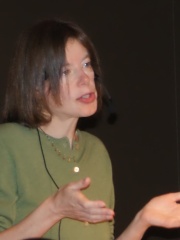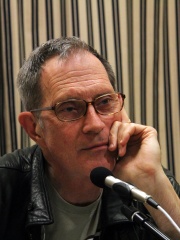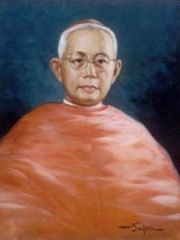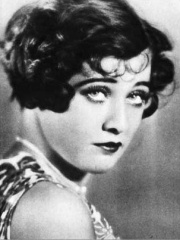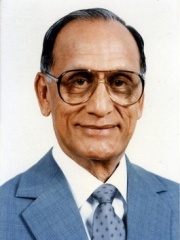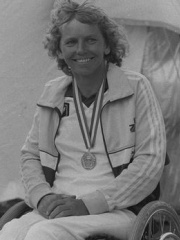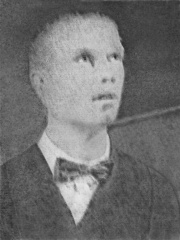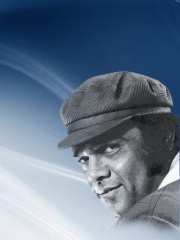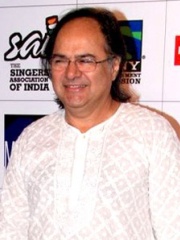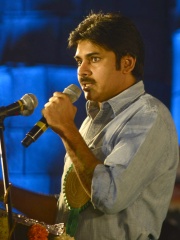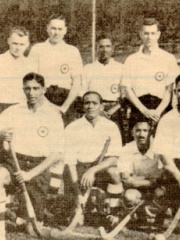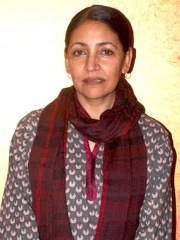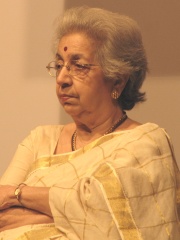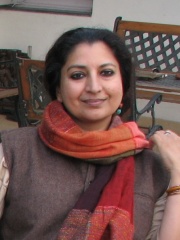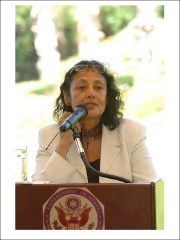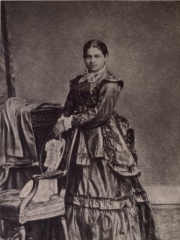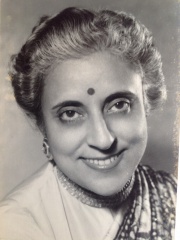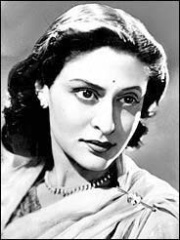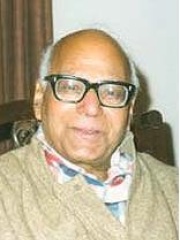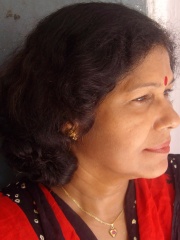WRITER
Raja Rao
1908 - 2006
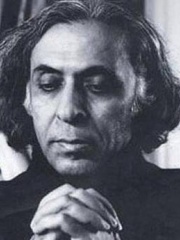
 Raja Rao
Raja Rao
Raja Rao (8 November 1908 – 8 July 2006) was an Indian-American writer of English-language novels and short stories, whose works are deeply rooted in metaphysics. The Serpent and the Rope (1960), a semi-autobiographical novel recounting a search for spiritual truth in Europe and India, established him as one of the finest Indian prose stylists and won him the Sahitya Akademi Award in 1963. For the entire body of his work, Rao was awarded the Neustadt International Prize for Literature in 1988. Read more on Wikipedia
Since 2007, the English Wikipedia page of Raja Rao has received more than 1,051,103 page views. His biography is available in 19 different languages on Wikipedia (up from 18 in 2019). Raja Rao is the 6,893rd most popular writer (down from 6,124th in 2019), the 1,130th most popular biography from India (down from 892nd in 2019) and the 132nd most popular Indian Writer.
Memorability Metrics
1.1M
Page Views (PV)
36.82
Historical Popularity Index (HPI)
19
Languages Editions (L)
1.33
Effective Languages (L*)
3.93
Coefficient of Variation (CV)
Notable Works
Page views of Raja Raos by language
Over the past year Raja Rao has had the most page views in the English wikipedia edition with 107,168 views, followed by Kannada (1,484), and Hindi (1,471). In terms of yearly growth of page views the top 3 wikpedia editions are Hindi (37.99%), Malayalam (37.67%), and Egyptian Arabic (36.36%)
Among WRITERS
Among writers, Raja Rao ranks 6,893 out of 7,302. Before him are Walter Jon Williams, Susan Faludi, Alexis Jenni, Geoff Ryman, Shamsul Maidin, and Charles Krauthammer. After him are Benjamin Jowett, Sayed Kashua, Sandi Toksvig, Abdourahman Waberi, Richard Flanagan, and Kiran Desai.
Most Popular Writers in Wikipedia
Go to all RankingsWalter Jon Williams
1953 - Present
HPI: 36.91
Rank: 6,887
Susan Faludi
1959 - Present
HPI: 36.89
Rank: 6,888
Alexis Jenni
1963 - Present
HPI: 36.89
Rank: 6,889
Geoff Ryman
1951 - Present
HPI: 36.88
Rank: 6,890
Shamsul Maidin
1966 - Present
HPI: 36.85
Rank: 6,891
Charles Krauthammer
1950 - 2018
HPI: 36.84
Rank: 6,892
Raja Rao
1908 - 2006
HPI: 36.82
Rank: 6,893
Benjamin Jowett
1817 - 1893
HPI: 36.81
Rank: 6,894
Sayed Kashua
1975 - Present
HPI: 36.77
Rank: 6,895
Sandi Toksvig
1958 - Present
HPI: 36.76
Rank: 6,896
Abdourahman Waberi
1965 - Present
HPI: 36.75
Rank: 6,897
Richard Flanagan
1961 - Present
HPI: 36.75
Rank: 6,898
Kiran Desai
1971 - Present
HPI: 36.75
Rank: 6,899
Contemporaries
Among people born in 1908, Raja Rao ranks 428. Before him are Polly Ann Young, Rufino Santos, Gene Raymond, Roop Singh, Sally O'Neil, and Dennis Morgan. After him are Penny Singleton, Will Lee, and Fearless Nadia. Among people deceased in 2006, Raja Rao ranks 404. Before him are Mihály Fülöp, Sarah Caldwell, Jesús Rollán, Corinne Rey-Bellet, Henry M. Morris, and Noor Hassanali. After him are Neroli Fairhall, Paul Hunter, Mohammed Bijeh, Chris Heunis, Francisco Javier Toledo, and Muhammadu Maccido.
Others Born in 1908
Go to all RankingsPolly Ann Young
ACTOR
1908 - 1997
HPI: 39.27
Rank: 422
Rufino Santos
RELIGIOUS FIGURE
1908 - 1973
HPI: 38.96
Rank: 423
Gene Raymond
ACTOR
1908 - 1998
HPI: 38.46
Rank: 424
Roop Singh
HOCKEY PLAYER
1908 - 1977
HPI: 37.72
Rank: 425
Sally O'Neil
ACTOR
1908 - 1968
HPI: 37.47
Rank: 426
Dennis Morgan
SINGER
1908 - 1994
HPI: 37.12
Rank: 427
Raja Rao
WRITER
1908 - 2006
HPI: 36.82
Rank: 428
Penny Singleton
ACTOR
1908 - 2003
HPI: 36.72
Rank: 429
Will Lee
ACTOR
1908 - 1982
HPI: 36.33
Rank: 430
Fearless Nadia
ACTOR
1908 - 1996
HPI: 30.71
Rank: 431
Others Deceased in 2006
Go to all RankingsMihály Fülöp
ATHLETE
1936 - 2006
HPI: 38.31
Rank: 398
Sarah Caldwell
MUSICIAN
1924 - 2006
HPI: 38.00
Rank: 399
Jesús Rollán
ATHLETE
1968 - 2006
HPI: 37.31
Rank: 400
Corinne Rey-Bellet
SKIER
1972 - 2006
HPI: 37.11
Rank: 401
Henry M. Morris
ENGINEER
1918 - 2006
HPI: 36.99
Rank: 402
Noor Hassanali
POLITICIAN
1918 - 2006
HPI: 36.99
Rank: 403
Raja Rao
WRITER
1908 - 2006
HPI: 36.82
Rank: 404
Neroli Fairhall
ATHLETE
1944 - 2006
HPI: 36.70
Rank: 405
Paul Hunter
SNOOKER
1978 - 2006
HPI: 36.46
Rank: 406
Mohammed Bijeh
EXTREMIST
1982 - 2006
HPI: 36.42
Rank: 407
Chris Heunis
POLITICIAN
1927 - 2006
HPI: 36.17
Rank: 408
Francisco Javier Toledo
SOCCER PLAYER
1959 - 2006
HPI: 35.97
Rank: 409
Muhammadu Maccido
POLITICIAN
1928 - 2006
HPI: 35.69
Rank: 410
In India
Among people born in India, Raja Rao ranks 1,130 out of 1,861. Before him are Radhika Sarathkumar (1962), Ahmed Rushdi (1934), Farooq Sheikh (1948), Pawan Kalyan (1971), Shraddha Kapoor (1987), and Richard Allen (1902). After him are Nawazuddin Siddiqui (1974), Pawan Kumar Chamling (1950), Deepti Naval (1952), Vijaya Mehta (1934), Kiran Desai (1971), and Shobhaa De (1948).
Others born in India
Go to all RankingsRadhika Sarathkumar
ACTOR
1962 - Present
HPI: 36.97
Rank: 1,124
Ahmed Rushdi
SINGER
1934 - 1983
HPI: 36.96
Rank: 1,125
Farooq Sheikh
ACTOR
1948 - 2013
HPI: 36.95
Rank: 1,126
Pawan Kalyan
ACTOR
1971 - Present
HPI: 36.94
Rank: 1,127
Shraddha Kapoor
ACTOR
1987 - Present
HPI: 36.91
Rank: 1,128
Richard Allen
ATHLETE
1902 - 1969
HPI: 36.85
Rank: 1,129
Raja Rao
WRITER
1908 - 2006
HPI: 36.82
Rank: 1,130
Nawazuddin Siddiqui
ACTOR
1974 - Present
HPI: 36.78
Rank: 1,131
Pawan Kumar Chamling
POLITICIAN
1950 - Present
HPI: 36.77
Rank: 1,132
Deepti Naval
ACTOR
1952 - Present
HPI: 36.76
Rank: 1,133
Vijaya Mehta
ACTOR
1934 - Present
HPI: 36.75
Rank: 1,134
Kiran Desai
WRITER
1971 - Present
HPI: 36.75
Rank: 1,135
Shobhaa De
WRITER
1948 - Present
HPI: 36.74
Rank: 1,136
Among WRITERS In India
Among writers born in India, Raja Rao ranks 132. Before him are Geetanjali Shree (1957), Ali Sardar Jafri (1913), Nayantara Sahgal (1927), Bharati Mukherjee (1940), Toru Dutt (1856), and Krishna Hutheesing (1907). After him are Kiran Desai (1971), Shobhaa De (1948), Kamala Markandaya (1924), Rupi Kaur (1992), Ram Swarup (1920), and Sarojini Sahoo (1956).
Geetanjali Shree
1957 - Present
HPI: 40.28
Rank: 126
Ali Sardar Jafri
1913 - 2000
HPI: 40.09
Rank: 127
Nayantara Sahgal
1927 - Present
HPI: 38.79
Rank: 128
Bharati Mukherjee
1940 - 2017
HPI: 37.63
Rank: 129
Toru Dutt
1856 - 1877
HPI: 37.39
Rank: 130
Krishna Hutheesing
1907 - 1967
HPI: 37.30
Rank: 131
Raja Rao
1908 - 2006
HPI: 36.82
Rank: 132
Kiran Desai
1971 - Present
HPI: 36.75
Rank: 133
Shobhaa De
1948 - Present
HPI: 36.74
Rank: 134
Kamala Markandaya
1924 - 2004
HPI: 36.41
Rank: 135
Rupi Kaur
1992 - Present
HPI: 36.38
Rank: 136
Ram Swarup
1920 - 1998
HPI: 36.19
Rank: 137
Sarojini Sahoo
1956 - Present
HPI: 35.76
Rank: 138

